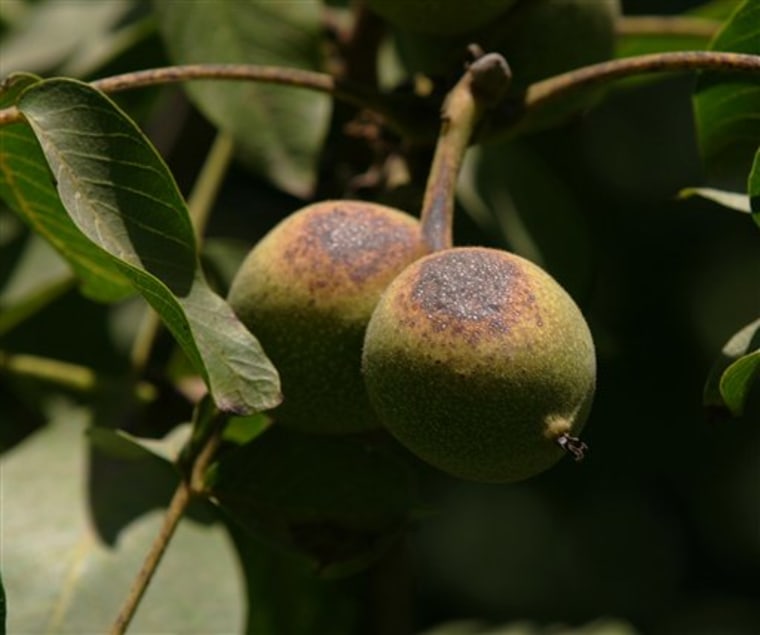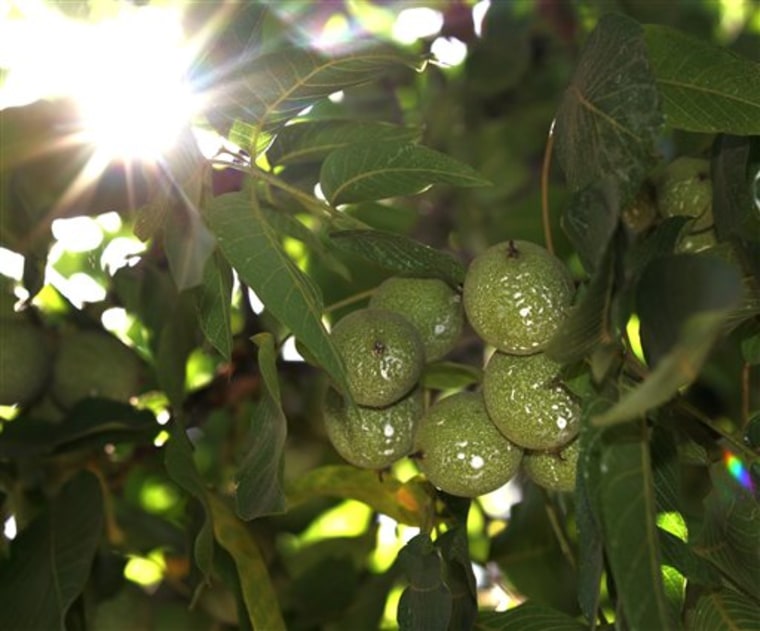Sunscreen for fruits and vegetables is being tested in Australia and Chile, and now California farmers are checking it out courtesy of a local vendor.
Just like people damage their skin in the sun, produce can also get nasty burns. That's why farmers are increasingly applying sunscreen to their crops to prevent skin blistering, heat stress and blemishes.
Sunspots on a Granny Smith apple can mean the difference between the lowest price for juice or the more lucrative fresh fruit market. As for nuts, last year buyers paid on average 3-cents a 1 pound more for sunscreen-protected nuts than untreated ones, said grower Ed Lagrutta as stood in the bed of his Chevy Silverado inspecting a San Joaquin Valley walnut grove in its second year of sunscreen tests. With yields topping 2,000 pounds an acre, it adds up, he said.
"With the costs of production going up, growers are looking to increase their margins wherever they can," said Lagrutta, an adviser for Western Farm Services who farms 20 acres and runs tests on hundreds more.
Climate change and drought in Australia and California's Central Valley have meant challenging growing conditions for farmers that are affecting the quality, yields and price of produce. Sunscreens alleviate at least one worry for farmers, who lose money with each fruit or vegetable that develops sun damage.
"I spend a lot of time studying drought," said Eric Wood, Ph.D., a professor of civil and environmental engineering at Princeton University and an expert on hydrology and climate change. "Under climate change, heat stress will become a bigger issue for plants, especially when it creates new heat-released disease. Corn under stress is reflected in smaller ears and lower yields."
Plants react to sun stress like humans. They perspire — a process called transpiration — which means the more temperatures rise, the more water they need. As drought grips several of the world's key growing regions, scientists are looking at ways to conserve by helping plants use less.
SPF 45
Liquefied clay has been used for years, but now a California company is finding positive results with an SPF 45 product made of multicrystaline calcium carbonate crystals that are engineered to specifically deflect ultraviolet and infrared light from the plants and trees on which it is sprayed. The product keeps out the bad light, but lets in the good photosynthesis rays that aid ripening.
The sunscreen has been tested in Australia and Chile, where UV rays affect production, and is in the second year of field tests in California.
Tests show its immediate impact is increasing yields by diminishing stress and heat-related defects, but officials at Purfresh in Fremont hope the product also can play a role in water and energy conservation by increasing a plant's water efficiency.
"We are where Silicon Valley meets the Central Valley," said Purfresh chief executive David Cope, who left information technology after 25 years for what he describes as "clean technology."
"We're using technology to address food and water availability, which affects consumer prices," he said.

The company has gained attention for its ozone sanitation system for water, produce packing and cold storage stabilization.
But it was its new sunscreen Purshade that lured 20 U.S. and international farm product researchers and advisers to a walnut grove near Visalia, Calif., last week.
The product also is being tested on tomatoes, grapes, kiwis and lychees in Australia, said Kerrie Mackay, who works for a company that sells crop protection products in Queensland, which she says is in 140-year drought.
"Sunburning is a big problem for us," she said watching Lagrutta compare the telltale yellowing on one block of walnuts with a uniformly green plot sprayed with Purfresh. "We have some of the highest UV intensity in the world. With drought and climate change, finding ways to use water more efficiently is always important to us."
Winery's been using, too
Amador County's Shenandoah Valley in the arid Sierra Nevada foothills is far from the temperate Napa Valley, but Dick Cooper of Cooper Vineyards has been growing 100 acres of premium wine grapes since the 1980s by using vine canopies to shade bunches. When vines transpire, they don't use the water to produce stems, leaves and fruit. In dry years like this one vine vigor is slow and exposed bunches of his pinot grigio shrivel into something resembling an olive pit, he said.
For the second year, he sprayed Purshade sunscreen on several of his blocks of white grape varietals to help protect them. He says that during the crush the calcium carbonate crystals drop to the bottom of the fermentation tanks with the rest of the sediment that comes in on grapes, so taste isn't affected.
"I'm not an expert on anything, but I'm always interested in trying anything," he said. "When my vines don't put up enough canopy, I like to give them a little help."
